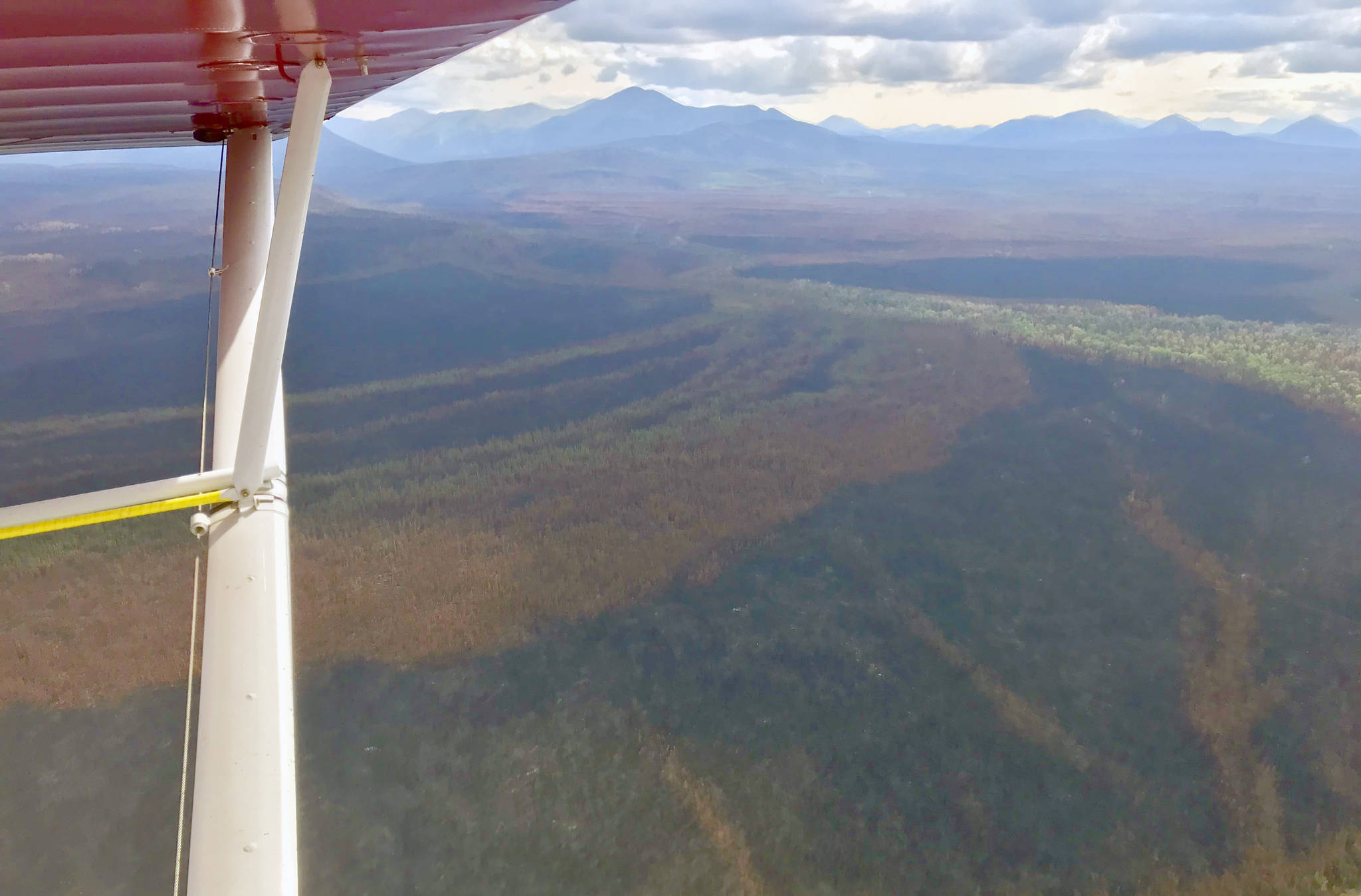This summer brought one of the hottest and driest summers ever recorded on the Kenai. Large areas dominated by black spruce, hot temperatures, and dry forests created perfect conditions for large-scale wildfires. With the recent Swan Lake fire burning over 163,000 acres and counting, a lot of people are asking, “What is happening to the wildlife?”
Wildfires can obviously be bad for some wildlife species, particularly those that cannot outrun the fire and smoke and take direct losses. Immediate loss of habitats also has some obvious negative effects that are often seen for many years. What isn’t clear as we drive down the Sterling Highway and look at the burn is that large unburned areas, which serve as refuges for wildlife, still remain.
Fires that burn a mosaic pattern across the landscape are generally favorable because they create a variety of habitats for all wildlife. I recently flew over much of the burn area and the fire appears to have burned in a mosaic pattern in many areas, which should stimulate regeneration and increase habitat variation across the landscape.
Even from the air, signs of new regeneration are already clearly evident in areas that burned earlier this summer. Moose have already moved back into many of these areas to take advantage of the new growth.
Fire management on refuge lands is largely focused on promoting a natural fire regime to the extent possible. In ecosystems where wildfires naturally occur, periodic fires are an essential part of ecosystem function and are ultimately good for most terrestrial wildlife. For example, periodic fires promote increased variety of tree species and sizes, making forests more resilient to other deleterious factors like spruce beetle outbreaks during dry summers.
Although fires have short-term negative effects for some wildlife, other species greatly benefit from fires and subsequent regeneration. Burn areas will likely experience initial declines in some small mammal species that rely on dense ground cover.
The effects of the fire on the Kenai Lowlands caribou herd are unknown. Caribou may be negatively affected by reductions in arboreal lichens on their wintering grounds, but they may also take advantage of new growth in the burn area.
Species like spruce grouse and snowshoe hare are intricately linked to successional vegetation stages and benefit from increased growth and habitat variety after fires.
Many other migratory and nonmigratory bird species also ultimately benefit from increased variation in forest structure. Dall sheep might even benefit to an extent because unusually dry conditions this summer allowed the fire to burn into alpine habitats, which promotes the growth of Trisetum spicatum and Festuca rubra, two grasses that are important forage for Dall sheep.
Some species in particular benefit greatly from burned areas. Take for example the iconic Kenai moose. Prior to the 1900s, moose were reportedly not very common on the Kenai.
Landscape changes created key moose habitats that allowed populations to flourish, resulting in dramatic increases in moose abundance during the early part of the century. A major factor driving these large-scale habitat changes, and associated increases in moose abundance, were large fires that occurred during the earlier part of the century.
During the mid-1900s, the Kenai became world renowned for its moose, which were reported to “occur at high abundance and display large antlers.” In 1941, President F.D. Roosevelt established the Kenai National Moose Range “for the purpose of protecting the natural breeding and feeding range of the giant Kenai moose. …”
The Kenai National Moose Range was eventually absorbed into the National Wildlife Refuge System and renamed the Kenai National Wildlife Refuge in 1980.
On the northern Kenai Peninsula, mature forests are largely composed of spruce forests, which are less productive than earlier successional stage mixed forests. Prime moose habitats consist of early successional stage vegetation including birch, willows, poplar and aspen. Periodic fires are a key natural factor reducing mature spruce forest stands and facilitating new growth of these hardwood forage species.
During the past century, moose abundance on the northern Kenai Peninsula has fluctuated considerably due to harsh winters, habitat succession, increased spruce forests, predation, human harvests and other factors. Large fires on the northern Kenai Peninsula during the 1940s and 1960s created large areas of productive moose habitats.
However, with a lack of significant fires since 1970, moose abundance in the area has declined, remaining chronically limited by increases of mature spruce forests and decreased hardwood forage availability as hardwood species grow out of reach for moose. Declines in moose abundance in this area have also reduced opportunities for subsistence and sport harvests by local residents.
Although a variety of factors ultimately influence how wildlife populations react to large burns, the Swan Lake fire probably represents a large-scale habitat improvement for moose and a variety of other wildlife species for many years to come.
Dom Watts is a Wildlife Biologist at Kenai National Wildlife Refuge. Find more Refuge Notebook articles (1999–present) at https://www.fws.gov/Refuge/Kenai/community/Refuge_notebook.html.

